5.9: Problems
- Page ID
- 69440
Section 5-1
A charge \(q\) of mass \(m\) moves through a uniform magnetic field \(B_{0} \textbf{i}_{z}\). At \( t =0\) its velocity and displacement are
\(\textbf{v} (t = 0) = v_{x0} \textbf{i}_{x} + v_{y0} \textbf{i}_{y} + v_{z0} \textbf{i}_{z} \\ \textbf{r}(t = 0) = x_{0} \textbf{i}_{x} + y_{0} \textbf{i}_{y} + z_{0} \textbf{i}_{z}\)
(a) What is the subsequent velocity and displacement?
(b) Show that its motion projected onto the \(xy\) plane is a circle. What is the radius of this circle and where is its center?
(c) What is the time dependence of the kinetic energy of the charge \(\frac{1}{2} m \vert \textbf{v} \vert ^{2}\)?
A magnetron is essentially a parallel plate capacitor stressed by constant voltage \(V_{0}\) where electrons of charge \( -e\) are emitted at \(x = 0, \,y = 0\) with zero initial velocity. A transverse magnetic field \(B_{0} \textbf{i}_{z}\) is applied. Neglect the electric and magnetic fields due to the electrons in comparison to the applied field.
(a) What is the velocity and displacement of an electron, injected with zero initial velocity at \(t = 0\)?
(b) What value of magnetic field will just prevent the electrons from reaching the other electrode? This is the cut-off magnetic field.
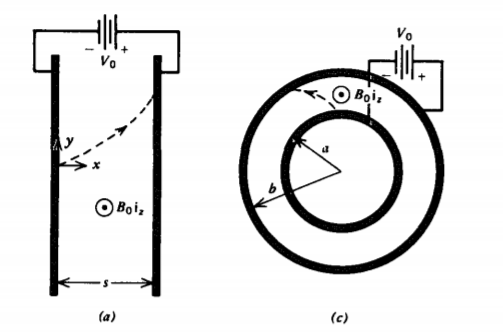
(c) A magnetron is built with coaxial electrodes where electrons are injected from \(r = a, \,\phi=0\) with zero initial velocity. Using the relations from Table 1-2,
\(\textbf{i}_{\textrm{r}} = \cos \phi \textbf{i}_{x} + \sin \phi \textbf{i}_{y} \\ \textbf{i}_{\phi} = - \sin \phi \textbf{i}_{x} + \cos \phi \textbf{i}_{y}\)
show that
\(\frac{d \textbf{i}_{\textrm{r}}}{dt} = \textbf{i}_{\phi} \frac{d \phi}{d t} = \frac{v_{\phi}}{\textrm{r}} \textbf{i}_{\phi} \\ \frac{d \textbf{i}_{\phi}}{dt} = - \textbf{i}_{\textrm{r}} \frac{d \phi}{dt} = - \frac{v_{\phi}}{\textrm{r}} \textbf{i}_{\textrm{r}}\)
What is the acceleration of a charge with velocity
\(\textbf{v} = v_{\textrm{r}} \textbf{i}_{\textrm{r}} + v_{\phi} \textbf{i}_{\phi}\) ?
(d) Find the velocity of the electrons as a function of radial position.
Hint:
\(\frac{dv_{\textrm{r}}}{dt} = \frac{dv_{\textrm{r}}}{d \textrm{r}} \frac{d \textrm{r}}{dt} = v_{\textrm{r}} \frac{dv_{\textrm{r}}}{d \textrm{r}} = \frac{d}{d \textrm{r}} (\frac{1}{2} v_{\textrm{r}}^{2}) \\ \frac{dv_{\phi}}{dt} = \frac{dv_{\phi}}{d \textrm{r}} \frac{d \textrm{r}}{dt} = v_{\textrm{r}} \frac{dv_{\phi}}{d \textrm{r}} \)
(e) What is the cutoff magnetic field? Check your answer with (b) in the limit \(b = a +s \) where \(s\ll a\).
A charge \(q\) of mass \(m\) within a gravity field \(-g\textbf{i}_{y}\) has an initial velocity \(v_{0} \textbf{i}_{x}\). A magnetic field \(B_{0} \textbf{i}_{z}\) is applied. What value of \(B_{0}\) will keep the particle moving at constant speed in the \(x\) direction?
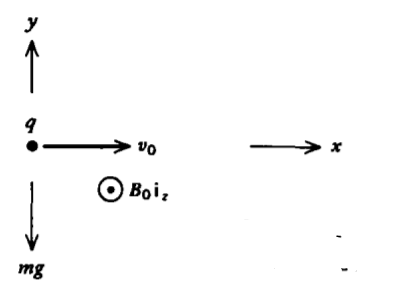
The charge to mass ratio of an electron \(e/m\) was first measured by Sir J. J. Thomson in \(1897\) by the cathode-ray tube device shown. Electrons emitted by the cathode pass through a slit in the anode into a region with crossed electric and magnetic fields, both being perpendicular to the electrons velocity. The end of the tube is coated with a fluorescent material that produces a bright spot where the electron beam impacts.
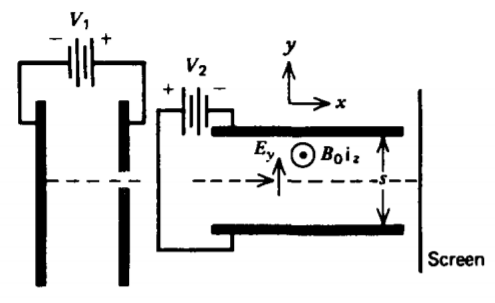
(a) What is the velocity of the electrons when passing through the slit if their initial cathode velocity is \(v_{0}\)?
(b) The electric field \(\textbf{E}\) and magnetic field \(\textbf{B}\) are adjusted so that the vertical deflection of the beam is zero. What is the initial electron velocity? (Neglect gravity.)
(c) The voltage \(V_{2}\) is now set to zero. What is the radius \(R\) of the electrons motion about the magnetic field?
(d) What is \(e/m\) in terms of \(E\), \(B\), and \(R\)?
A charge \(q\) of mass \(m\) at \(t = 0\) crosses the origin with velocity \(\textbf{v}_{0} = \textbf{v}_{x0} \textbf{i}_{x} + v_{y 0} \textbf{i}_{y}\). For each of the following applied magnetic fields, where and when does the charge again cross the \(y =0\) plane?
(a) \(\textbf{B} = B_{0} \textbf{i}_{x}\)
(b) \(\textbf{B} = B_{0} \textbf{i}_{y}\)
(c) \(\textbf{B} = B_{0} \textbf{i}_{z}\)
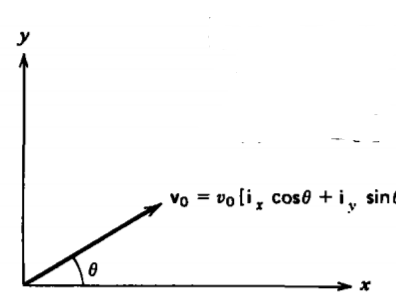
In 1896 Zeeman observed that an atom in a magnetic field had a fine splitting of its spectral lines. A classical theory of the Zeeman effect, developed by Lorentz, modeled the electron with mass \(m\) as being bound to the nucleus by a springlike force with spring constant \(k\) so that in the absence of a magnetic field its natural frequency was \(\omega_{k} = \sqrt{k/m}\)
(a) A magnetic field \(B_{0}\textbf{i}_{z}\) is applied. Write Newton's law for the \(x\), \(y\), and \(z\) displacements of the electron including the spring and Lorentz forces.
(b) Because these equations are linear, guess exponential solutions of the form \(e^{st}\). What are the natural frequencies?
(c) Because \(\omega_{k}\) is typically in the optical range (\(\omega_{k} \approx 10^{15}\) radian/sec), show that the frequency splitting is small compared to \(\omega_{k}\) even for a strong field of \(B_{0}\) = 1 tesla. In this limit, find approximate expressions for the natural frequencies of (b).
A charge \(q\) moves through a region where there is an electric field \(\textbf{E}\)E and magnetic field \(\textbf{E}\)B. The medium is very viscous so that inertial effects are negligible,
\(\beta \textbf{v} = q (\textbf{E} + \textbf{v} \times \textbf{B})\)
where \(\beta\) is the viscous drag coefficient. What is the velocity of the charge? (Hint: \(\textbf{v} \times \textbf{B} = - \textbf{v} (\textbf{B} \cdot \textbf{B}) + \textbf{B}(\textbf{v} \cdot \textbf{B})\) and \(\textbf{v} \cdot \textbf{B} = (q/\beta) \textbf{E} \cdot \textbf{B}.\) )
Charges of mass \(m\), charge \(q\), and number density \(n\) move through a conducting material and collide with the host medium with a collision frequency \(\nu\) in the presence of an electric field \(\textbf{E}\) and magnetic field \(\textbf{B}\).
(a) Write Newton's first law for the charge carriers, along the same lines as developed in Section 3-2-2, with the addition of the Lorentz force.
(b) Neglecting particle inertia and diffusion, solve for the particle velocity \(\textbf{v}\).
(c) What is the constitutive law relating the current density \(\textbf{J}=qn\textbf{v}\) to \(\textbf{E}\) and \(\textbf{B}\). This is the generalized Ohm's law in the presence of a magnetic field.
(d) What is the Ohmic conductivity \(\sigma\)? A current \(i\) is passed through this material in the presence of a perpendicular magnetic field. A resistor \(R_{L}\) is connected across the terminals. What is the Hall voltage? (See top of page 379).
(e) What value of \(R_{L}\) maximizes the power dissipated in the load?

Section 5-2
A point charge \(q\) is traveling within the magnetic field of an infinitely long line current \(I\). At \(r = r0\) its velocity is
\(\textbf{v} (t = 0) = v_{r0} \textbf{i}_{\textrm{r}} + v_{\phi 0} \textbf{i}_{\phi} + v_{z0} \textbf{i}_{z}\)
Its subsequent velocity is only a function of \(r\).
(a) What is the velocity of the charge as a function of position? Hint: See Problem 2c and 2d,
\( \int \frac{\ln x}{x} dx = \frac{1}{2} (\ln x)^{2}\)
(b) What is the kinetic energy of the charge?
(c) What is the closest distance that the charge can approach the line current if \(v_{\phi 0} = 0 \)?
Find the magnetic field at the point P shown for the following line currents:

Two long parallel line currents of mass per unit length \(m\) in a gravity field \(g\) each carry a current \(I\) in opposite directions. They are suspended by cords of length \(l\). What is the angle \(\theta\) between the cords?
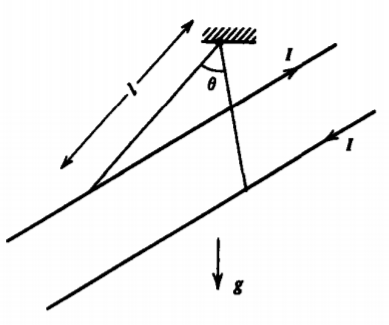
A constant current \(K_{0} \textbf{i}_{\phi}\) flows on the surface of a sphere of radius \(R\).

(a) What is the magnetic field at the center of the sphere? (HINT: \(\textbf{i}_{\phi} \times \textbf{i}_{r} = \textbf{i}_{\phi} = \cos \theta \cos \phi \textbf{i}_{x} + \cos \theta \sin \phi \textbf{i}_{y} - \sin \theta \textbf{i}_{z}\).)
(b) Use the results of (a) to find the magnetic field at the center of a spherical shell of inner radius \(R_1\) and outer radius \(R_2\) carrying a uniformly distributed volume current \(J_{0} \textbf{i}_{\phi}\).
A line current \(I\) of length \(2L\) flows along the \(z\) axis.
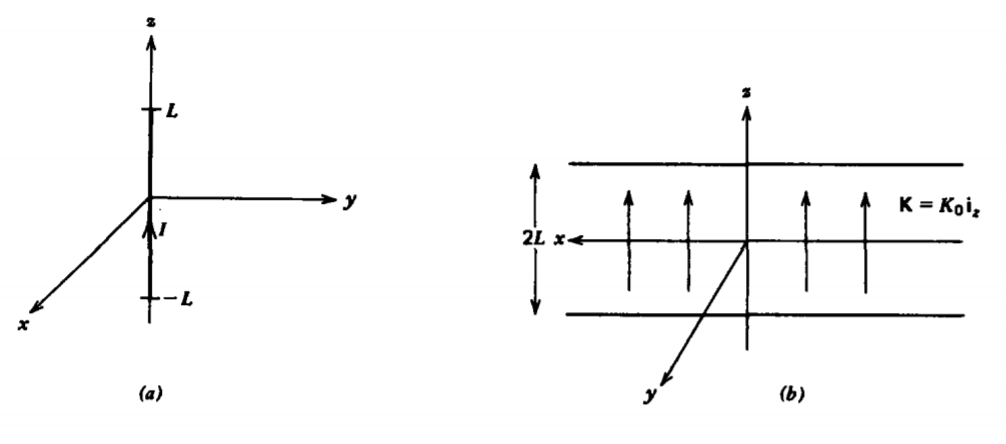
(a) What is the magnetic field everywhere in the \(z =0\) plane?
(b) Use the results of (a) to find the magnetic field in the \(z = 0\) plane due to an infinitely long current sheet of height \(2L\) and uniform current density \(K_{0}\textbf{i}_{z}\). Hint: Let \(u=x^{2} + y^{2}\)
\(\int \frac{du}{u(u^{2} + bu - a)^{1/2}} = \frac{1}{\sqrt{a}} \sin^{-1} \bigg( \frac{bu + 2a}{u \sqrt{b^{2} + 4a}} \bigg) \)
Closely spaced wires are wound about an infinitely long cylindrical core at pitch angle \(\theta_{0}\). A current flowing in the wires then approximates a surface current
\(\textbf{K} = K_{0} (\textbf{i}_{z} \sin \theta_{0} + \textbf{i}_{\phi} \cos \theta_{0})\)
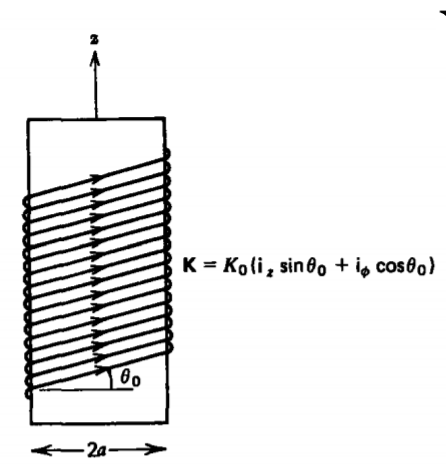
What is the magnetic field everywhere?
An infinite slab carries a uniform current \(J_{0}\textbf{i}_{z}\) except within a cylindrical hole of radius \(a\) centered within the slab.
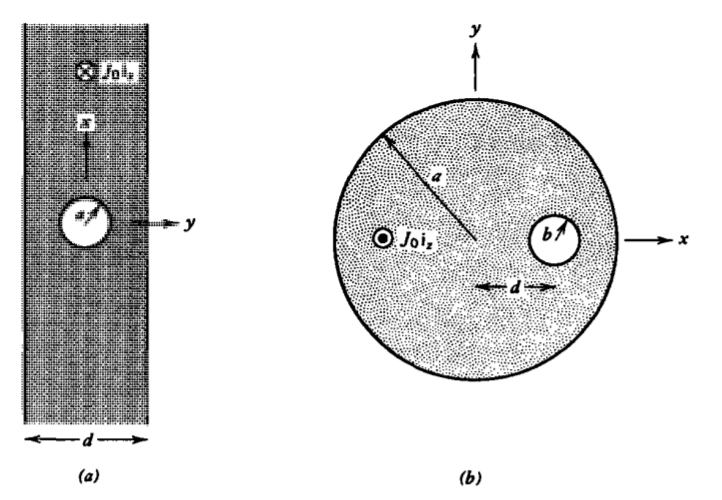
(a) Find the magnetic field everywhere? (Hint: Use superposition replacing the hole by two oppositely directed currents.)
(b) An infinitely long cylinder of radius \(a\) carrying a uniform current \(J_{0}\textbf{i}_{z}\) has an off-axis hole of radius \(b\) with center a distance \(d\) from the center of the cylinder. What is the magnetic field within the hole? (Hint: Convert to Cartesian coordinates \(\textrm{r} \textbf{i}_{\phi} = x \textbf{i}_{y}- y \textbf{i}_{x}\))
Section 5.3
Which of the following vectors can be a magnetic field \(\textbf{B}\)? If so, what is the current density \(\textbf{J}\)?
(a) \(\textbf{B} = a r \textbf{i}_{r}\)
(b) \(\textbf{B} = a (x \textbf{i}_{y} - y \textbf{i}_{x})\)
(c) \(\textbf{B} = a (x \textbf{i}_{x} - y \textbf{i}_{y})\)
(d) \(\textbf{B} = a \textrm{r} \textbf{i}_{\phi}\)
Find the magnetic field everywhere for each of the following current distributions:
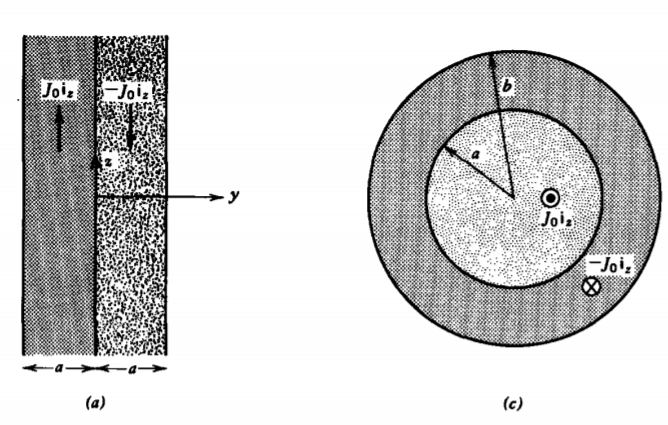
(a) \(\textbf{J} = \left \{ \begin{matrix} J_{0} \textbf{i}_{z}, & -a < y < 0 \\ -J_{0}\textbf{i}_{z,} & 0 < y < a \end{matrix} \right. \)
(b) \(\textbf{J} = \frac{J_{0}y}{a} \textbf{i}_{z}, \: \: \: \: -a < y < a \)
(c) \(\textbf{J} = \left \{ \begin{matrix} J_{0}\textbf{i}_{z}, & 0 < \textrm{r} < a \\ -J_{0} \textbf{i}_{z}, & a < \textrm{r} < b \end{matrix} \right. \)
(d) \(\textbf{J} = \left \{ \begin{matrix} \frac{J_{0} \textrm{r}}{a} \textbf{i}_{z}, & \textrm{r} < a \\ 0, & \textrm{r} > a \end{matrix} \right. \)
Section 5.4
Two parallel semi-infinite current sheets a distance \(d\) apart have their currents flowing in opposite directions and extend over the interval \( - \infty < x < 0\).

(a) What is the vector potential? (Hint: Use superposition of the results in Section 5-3-4b.)
(b) What is the magnetic field everywhere?
(c) How much magnetic flux per unit length emanates through the open face at \(x = 0\)? How much magnetic flux per unit length passes through each current sheet?
(d) A magnetic field line emanates at the position \(y_{0} (0 < y_{0} < d)\) in the \(x = 0\) plane. At what value of \(y\) is this field line at \(x = - \infty\)?
(a) Show that \(\nabla \cdot \textbf{A} \neq 0\) for the finite length line current in Section 5-4-3a. Why is this so?
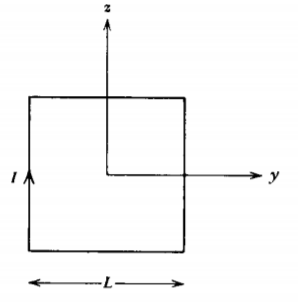
(b) Find the vector potential for a square loop.
(c) What is \(\nabla \cdot \textbf{A}\) now?
Find the magnetic vector potential and ma netic field for the following current distributions: (Hint: \(\nabla^{2} \textbf{A} = \nabla ( \nabla \cdot \textbf{A})\) )
(i) Infinitely long cylinder of radius a carrying a
(a) surface current \(K_{0} \textbf{i}_{\phi}\)
(b) surface current, \(K_{0} \textbf{i}_{z}\)
(c) volume current \(J_{0}\textbf{i}_{z}\)
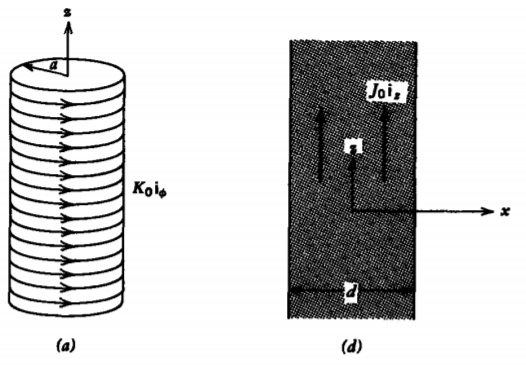
(ii) Infinitely long slab of thickness \(\)d carrying a
(d) volume current \(J_{0} \textbf{i}_{z}\)
(e) volume current \(\frac{J_{0}x}{d} \textbf{i}_{z}\)
Section 5.5
A general definition for the magnetic dipole moment for any shaped current loop is
\(\textbf{m} = \frac{1}{2} \oint \textbf{r} \times \textbf{I} dl\)
If the current is distributed over a surface or volume or is due to a moving point charge we use
\(\textbf{I} dl \rightarrow q \textbf{v} \rightarrow \textbf{K} d \textrm{S} \rightarrow \textbf{J} d \textrm{V}\)
What is the magnetic dipole moment for the following current distributions:
(a) a point charge q rotated at constant angular speed \(\omega\) at radius \(a\);
(b) a circular current loop of radius a carrying a current \(I\);
(c) a disk of radius a with surface current \(K_{0} \textbf{i}_{\phi}\);
(d) a uniformly distributed sphere of surface or volume charge with total charge \(\mathcal{Q}\) and radius \(R\) rotating in the \(\phi\) direction at constant angular speed \(\omega\). (Hint: \(\textbf{i}_{r} \times \textbf{i}_{\phi} = - \textbf{i}_{\theta} = - [ \cos \theta \cos \phi \textbf{i}_{x} + \cos \theta \sin \phi \textbf{i}_{y} - \sin \theta \textbf{i}_{z}]\))
Two identical point magnetic dipoles \(\textbf{m}\) with magnetic polarizability \(\alpha (\textbf{m} = \alpha \textbf{H})\) are a distance \(a\) apart along the \(z\) axis. A macroscopic field \(H_{0} \textbf{i}_{z}\) is applied.
(a) What is the local magnetic field acting on each dipole?
(b) What is the force on each dipole?

(c) Repeat (a) and (b) if we have an infinite array of such dipoles. Hint:
\(\sum_{n=1}^{\infty} \frac{1}{n^{3}} \approx 1.2\)
(d) If we assume that there is one such dipole within each volume of \(a^{3}\), what is the permeability of the medium?
An orbiting electron with magnetic moment \(m_{z} \textbf{i}_{z}\) is in a uniform magnetic field \(B_{0} \textbf{i}_{z}\) when at \(t = 0\) it is slightly displaced so that its angular momentum \(\textbf{L} = - (2m_{e}/e) \textbf{m}\) now also has x and y components.
(a) Show that the torque equation can be put in terms of the magnetic moment
\(\frac{d \textbf{m}}{dt} = - \gamma \textbf{m} \times \textbf{B}\)
where \(\gamma\) is called the gyromagnetic ratio. What is \(\gamma\)?
(b) Write out the three components of (a) and solve for the magnetic moment if at \(t =0 \)the moment is initially
\(\textbf{m} (t=0) = m_{x0} \textbf{i}_{x} + m_{y0} \textbf{i}_{y} + m_{z0} \textbf{i}_{z}\)
(c) Show that the magnetic moment precesses about the applied magnetic field. What is the precessional frequency?
What are the \(\textbf{B}\), \(\textbf{H}\), and \(\textbf{M}\) fields and the resulting magnetization currents for the following cases:
(a) A uniformly distributed volume current \(J_{0}\textbf{i}_{z}\) through a cylinder of radius a and permeability \(\mu\) surrounded by free space.
(b) A current sheet \(K_{0} \textbf{i}_{z}\) centered within a permeable slab of thickness \(d\) surrounded by free space.
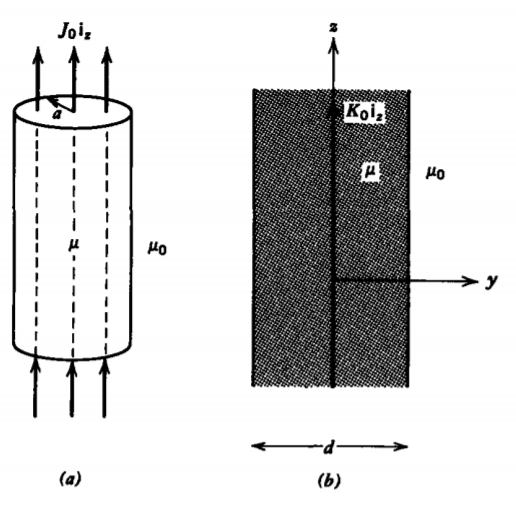
Section 5.6
A magnetic field with magnitude \(H_{1}\) is incident upon the flat interface separating two different linearly permeable materials at an angle \(\theta_{1}\) from the normal. There is no surface current on the interface. What is the magnitude and angle of the magnetic field in region 2?

A cylinder of radius a and length \(L\) is permanently magnetized as \(M_{0}\textbf{i}_{z}\).\
(a) What are the \(\textbf{B}\) and \(\textbf{H}\) fields everywhere along its axis?
(b) What are the fields far from the magnet \(\left ( r\gg a,\,r\gg L \right )\)?
(c) Use the results of (a) to find the \(\textbf{B}\) and \(\textbf{H}\) fields everywhere due to a permanently magnetized slab \(M_{0} \textbf{i}_{z}\) of infinite \(xy\) extent and thickness \(L\).
(d) Repeat (a) and (b) if the. cylinder has magnetization \(M_{0} (1-\textrm{r} /a) \textbf{i}_{z}\). Hint:
\(\int \frac{d \textrm{r}}{(a^{2} + \textrm{r}^{2})^{1/2}} = \ln (\textrm{r} + \sqrt{a^{2} + \textrm{r}^{2}})\)
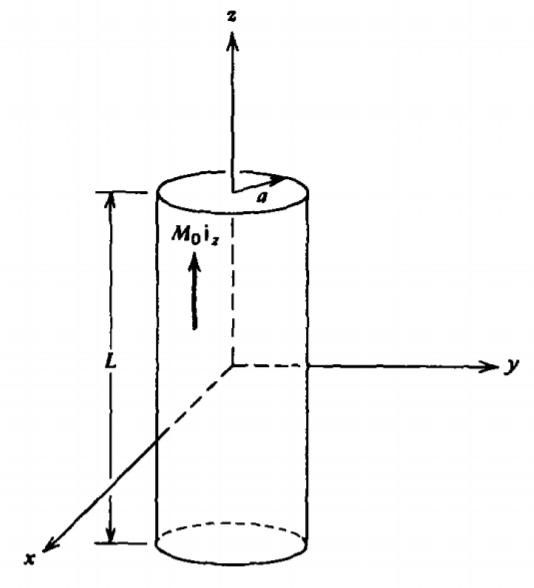
Section 5.7
A \(z\)-directed line current \(I\) is a distance d above the interface separating two different magnetic materials with permeabilities \(\mu_{1}\) and \(\mu_{2}\).

(a) Find the image currents \(I'\) at position \(x =-d\) and \(I"\) at \(x=d\) that satisfy all the boundary conditions. The field in region 1 is due to \(I\) and \(I' \) while the field in region 2 is due to \(I"\). (Hint: See the analogous dielectric problem in Section 3-3-3.)
(b) What is the force per unit length on the line current \(I\)?
An infinitely long line current \(I\) is parallel to and a distance \(D\) from the axis of a perfectly conducting cylinder of radius \(a\) carrying a total surface current \(I_{0}\).
(a) Find suitable image currents and verify that the boundary conditions are satisfied. (Hint: \(x \textbf{i}_{y} - y \textbf{i}_{x} = \textrm{r} \textbf{i}_{\phi}; \: \: \: \textbf{i}_{y} = \sin \phi \textbf{i}_{\textrm{r}} + \cos \phi \textbf{i}_{\phi}; \: x = \textrm{r} \cos \phi.\) )
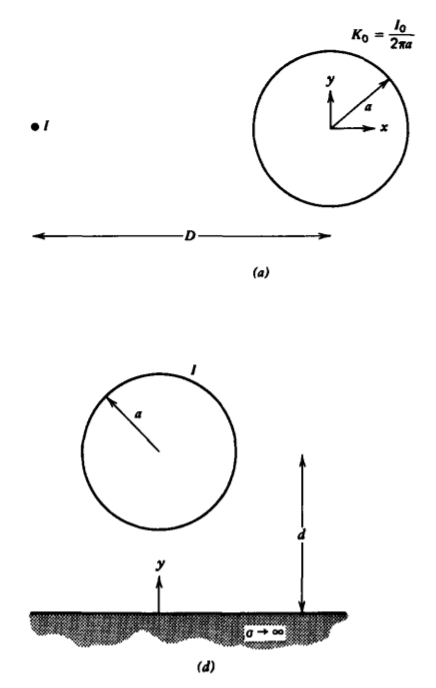
(b) What is the surface current distribution on the cylinder? What total current flows on the cylinder? Hint:
\(\int \frac{d \phi}{a + b \cos \phi} = \frac{2}{[a^{2} - b^{2}]^{1/2}} \tan^{-1} \bigg( \frac{[a^{2} - b^{2}]^{1/2} \tan (\frac{1}{2} \phi)}{(a + b)} \bigg)\)
(c) What is the force per unit length on the cylinder?
(d) A perfectly conducting cylinder of radius a carrying a total current \(I\) has its center a distance \(d\) above a perfectly conducting plane. What image currents satisfy the boundary conditions?
(e) What is the force per unit length on the cylinder?
A current sheet \(K_{0} \cos ay \textbf{i}_{z}\) is placed at \(x =0\). Because there are no volume currents for \(x \neq 0\), a scalar magnetic potential can be defined \(\textbf{H} = \nabla_{\chi}\).
(a) What is the general form of solution for \(\chi\)? (Hint: See Section 4-2-3.)
(b) What boundary conditions must be satisfied?
(c) What is the magnetic field and vector potential everywhere?
(d) What is the equation of the magnetic field lines?
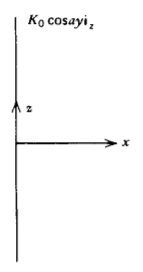
A slab of thickness \(d\) carries a volume current distribution \(J_{0} \sin a x \textbf{i}_{z}\) and is placed upon a perfectly conducting ground plane.
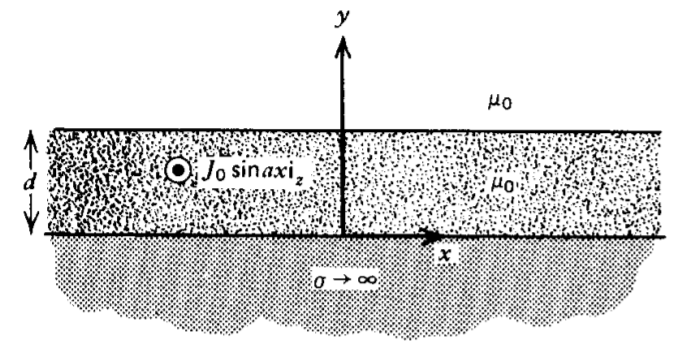
(a) Find a particular solution for the vector potential. Are all the boundary conditions satisfied?
(b) Show that additional solutions to Laplace's equations can be added to the vector potential to satisfy the boundary conditions. What is the magnetic field everywhere?
(c) What is the surface current distribution on the ground plane?
(d) What is the force per unit length on a section of ground plane of width \(2 \pi/a\)? What is the body force per unit length on a section of the current carrying slab of width \(2 \pi/a\)?
(e) What is the magnetic field if the slab carries no current but is permanently magnetized as \(M_{0} \sin ax \textbf{i}_{y}\) Repeat (c) and (d).
A line current of length \(L\) stands perpendicularly upon a perfectly conducting ground plane.
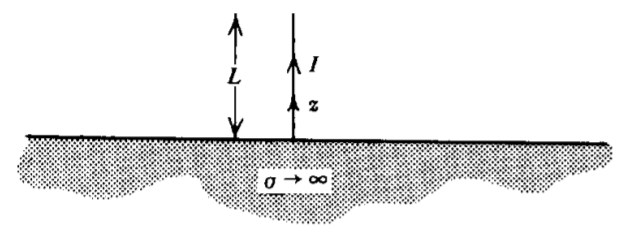
(a) Find a suitable image current that is equivalent to the induced current on the \(z =0\) plane. Does the direction of the image current surprise you?
(b) What is the magnetic field everywhere? (Hint: See Section 5-4-3a.)
(c) What is the surface current distribution on the conducting plane?
A cylinder of radius a is placed within a uniform magnetic field \(H_{0}\textbf{i}_{x}\) Find the magnetic field for each of the following cases:

(a) Cylinder has permeability \(\mu_{2}\) and surrounding medium has permeability \(\mu_{1}\)
(b) Perfectly conducting cylinder in free space.
(c) Uniformly magnetized cylinder \(M_{2} \textbf{i}_{x}\) in a uniformly magnetized medium \(M_{1} \textbf{i}_{x}\).
A current sheet \(K_{0} \textbf{i}_{z}\) is placed along the \(y\) axis at \(x =0\) between two parallel perfectly conducting planes a distance \(d\) apart.
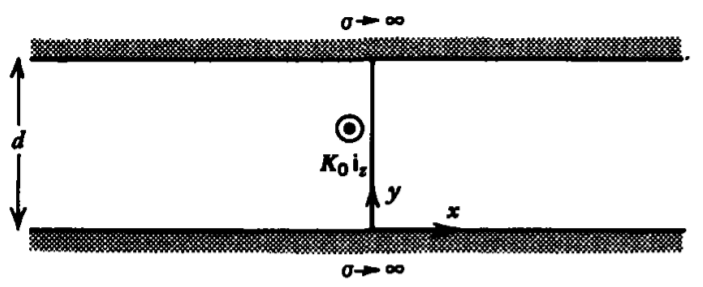
(a) Write the constant current at \(x =0\) as an infinite Fourier series of fundamental period \(2d\). (Hint: See Section 4-2-5.)
(b) What general form of a scalar potential \(\chi\), where \(\textbf{H} = \nabla_{\chi}\), will satisfy the boundary conditions?
(c) What is the magnetic field everywhere?
(d) What is the surface current distribution and the total current on the conducting planes? Hint:
\(\sum_{n=1 \\ (n \textrm{ odd})}^{\infty} \frac{1}{n^{2}} = \frac{\pi^{2}}{8}\)
Section 5.8
An infinitely long cylinder of radius \(a\) is permanently magnetized as \(M_{0} \textbf{i}_{x}\)
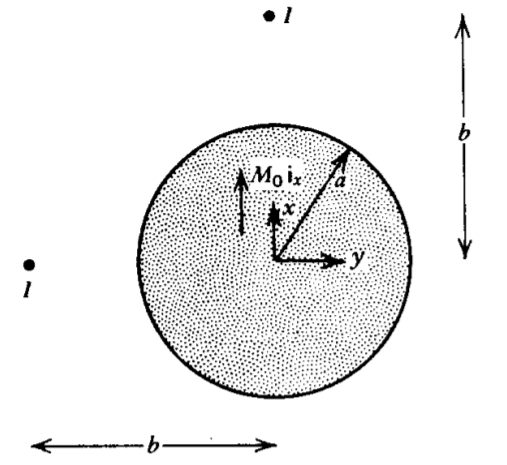
(a) Find the magnetic field everywhere.
(b) An infinitely long line current \(I\) is placed either at \(y = -b\) or at \(x = b \,(b > a)\). For each of these cases, what is the force per unit length on the line current? (Hint: See problem 32c.)
Parallel plate electrodes are separated by a rectangular conducting slab that has a permeability \(\mu\). The system is driven by a dc current source.

(a) Neglecting fringing field effects assume the magnetic field is \(H_{z}(x) \textbf{i}_{z}\). If the current is uniformly distributed throughout the slab, find the magnetic field everywhere.
(b) What is the total force on the slab? Does the force change with different slab permeability? Why not?
A permeable slab is partially inserted into the air gap of a magnetic circuit with uniform field \(H_{0}\). There is a nonuniform fringing field right outside the magnetic circuit near the edges.
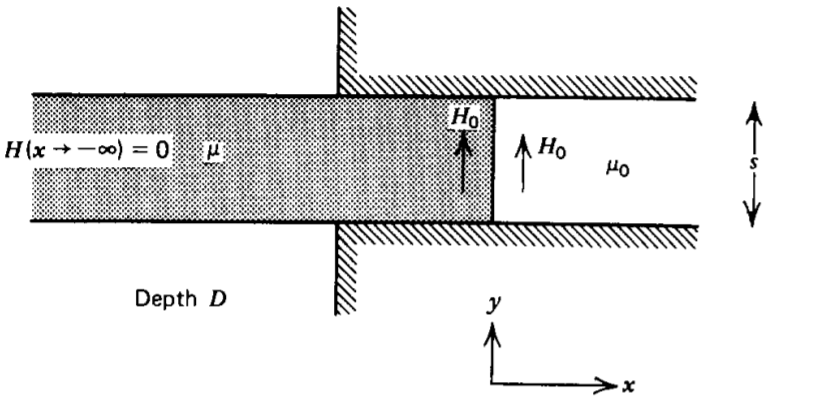
(a) What is the total force on the slab in the \(x\) direction?
(b) Repeat (a) if the slab is permanently magnetized \(\textbf{M} = M_{0} \textbf{i}_{y}\). (Hint: What is \(H_{x}(x = - \infty)\)? See Example 5-2a.)


